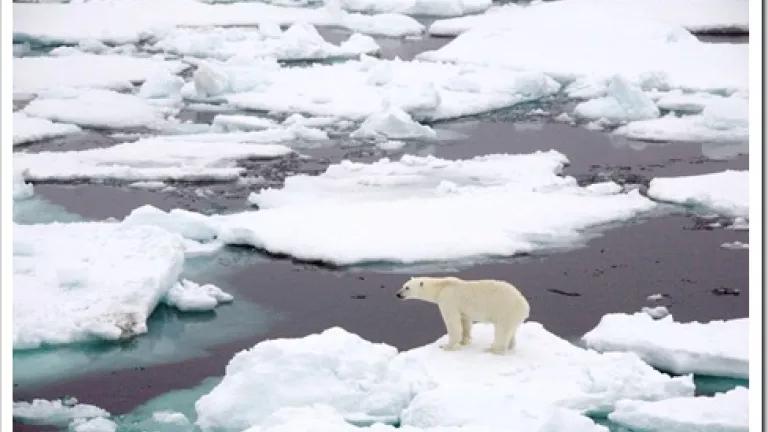
Arguably, one the most successful international environmental agreements, at least when it comes to wildlife, is the Convention on International Trade in Endangered Species or “CITES” (pronounced “cy-tees”). CITES is designed to control international commercial trade in endangered species, and to increase oversight of other noncommercial uses, such as the export hunting trophies. It does this by placing species on one of three “Appendices” (Appendix III, Appendix, II, or Appendix I). With each successive step up the ladder, from III to I, international restrictions on trade and noncommercial use increase. Right now, the United States is considering whether to propose moving the polar bear from an Appendix II species to the more restrictive Appendix I list at the next CITES meeting, this coming March. We need to urge the Fish and Wildlife to do so.
There are 20,000 – 25,000 polar bears roaming the circumpolar Arctic today, divided into 19 subpopulations. As you can see from the map below, nearly two-thirds of those populations are found in Canada. The trouble is, Canada allows widespread polar bear trophy hunting by tourists and the commercial trade of polar bear parts.
Over 80 percent of polar bear hunting in Canada occurs in the Nunavut and Northwest Territories. Trophy hunting, which only occurs in Canada, forms a part of the quota assigned to communities in these territories, where a small number of hunting tags are effectively sold to non-indigenous trophy hunters. Every year, polar bear sports hunters take as many as 100 individual bears, which are later exported out of Canada as personal property.
In addition to trophy hunting, international trade is also an integral part of polar bear harvest. The United Nations Environment Programme World Conservation Monitoring Centre tracks the international trade of CITES species and reports that over the last 10 years, nearly 9,000 polar bear specimens were exported for commercial purposes. These specimens included 2,849 skins, 108 skulls, and 1,249 claws. For all trade purposes (commercial, trophy hunt, etc.), over 1,300 polar bear skulls entered into international trade, as well as 4,238 skins, 2,114 specimens of teeth, and 3,455 claws or claw sets.
It’s important to emphasize here that NRDC has no problem with the sustainable subsistence use of polar bears by native peoples, whether they be in Canada or the United States. Indeed, when the polar bear was listed as a threatened species under the U.S. Endangered Species Act--an effort that NRDC helped lead--we were careful to point out that subsistence hunting would not be affected by the listing. But trophy hunting and hunting for commercial trade is, and should be, a different story. That’s in no small part because there’s considerable evidence that polar bears are being killed by hunters at an unsustainable rate.
The existence of unsustainable harvest levels was identified by the IUCN’s Red List of Threatened Species when it classified the polar bear as “vulnerable” in 2001. The United States Fish and Wildlife Services also identified overharvest as a potential risk to the polar bear when protecting it under the Endangered Species Act, concluding “that harvest may become a more important factor in the future for populations experiencing nutritional stress” due to global warming. In Canada, where trade and trophy hunting still occur, scientists found that the Chukchi Sea, Baffin Bay, Kane Basin, Western Hudson Bay and Davis Strait populations all may be overharvested. In 2008, unsustainable harvest of polar bears in Kane Basin and Baffin Bay led the European Union to ban the import of polar bear specimens derived from these two populations.
While overall polar bear harvest remains relatively low--and global warming certainly remains the overwhelming threat to the species--ongoing polar bear hunting can have unexpected and rapid negative impacts on populations. As I’ve written about before, through something called the “Allee effect” there is concern that the selective harvest of male polar bears by hunters could cause a sudden population collapse in some areas. And a precipitous decline in polar bear population could be hard to see, making it even more dangerous. In 2007 one study concluded that scientists would detect a 50 percent decrease in polar bear abundance over 15 years less than half the time.
All of this is made even more important by the crucial nature of the Canadian polar bear population. Based on projections of sea ice loss, scientists expect that polar bears’ last refuge in the wild--and the one place they may have hope of surviving long enough for us to deal effectively with global warming--is the Canadian Arctic archipelago. That makes it essential to reduce other forms of stress, such as trophy hunting, on these populations.
The United States has already done its part. By listing polar bears under the Endangered Species Act, the U.S. has effectively banned the import of polar bear trophies into the states (the U.S. Marine Mammal Protection Act has long banned commercial trade in polar bears). Now its time to urge the rest of the world to do the same. If polar bears are moved to Appendix I under CITES, the result will be much more international oversight of any hunting imports and the end of most commercial trade. So take a moment, go to NRDC’s action page, and urge the U.S. Fish and Wildlife Service to propose increased CITES protections.

